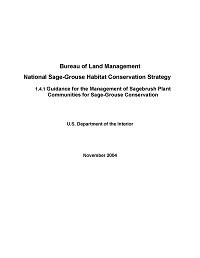BLM National Sage-Grouse Habitat Conservation Strategy 1.4.1 Guidance for the Management of Sagebrush Plant Communities for Sage-Grouse Conservation

This document serves as guidance on managing, restoring and enhancing sagebrush habitat on public lands administered by the Bureau of Land Management (BLM). This guidance only applies until BLM State or local-level guidance is developed, or until specific sage-grouse conservation measures are incorporated into BLM land use plans. In July 2000, the Western Association of Fish and Wildlife Agencies (WAFWA) entered into a Memorandum of Understanding (MOU) with the U.S. Forest Service (FS), U.S. Fish and Wildlife Service (FWS) and BLM. This MOU established state wildlife agencies as the lead for state and local conservation planning efforts for sage-grouse. In July 2002, WAFWA approved a proposal to develop a Conservation Assessment (CA) for sage-grouse and sage-grouse habitat to be completed in two distinct phases. Phase 1 is an assessment of sage-grouse populations and habitat status throughout their range across eleven western states. It was completed in June 2004. Phase 2, a range-wide plan for the conservation of sage-grouse and sage-grouse habitats, is scheduled for completion in 2005. BLM will consider guidance in these documents when developing strategies and plans in accordance with the MOU.
This guidance is designed to support and promote the range-wide conservation of sagebrush habitats for sage-grouse and other sagebrush-obligate wildlife species on public lands administered by the BLM. BLM States and associated Field Offices will utilize this guidance until the Bureau and its partners (1) finalize and adopt the BLM State-Level Strategies and/or state wildlife agency-led Sage-grouse Conservation Plans, and/or (2) incorporate sage-grouse habitat objectives and conservation measures into appropriate planning documents. This guidance may be modified through collaborative processes in each state in order to better fit local and regional conditions and to reflect ongoing efforts to complete state-level strategies. This guidance may not apply where locally-specific guidance has already been developed by BLM using the best available science.
